Do human resource management practices
have an impact on financial performance of
banks?
Human resource management (HRM) practices are being increasingly considered as major
contributory factors in financial performance of organizations. This research study effectively
highlights the importance of HRM practices with impact on financial performance of banks
(FPB) operating in Pakistan. The major objective of the study is to find out the relationship
between ‘HRM Practices’ and the ‘Financial Performance of Banks’. As a sample, 46 scheduled
banks were contacted, of which 38 responded. The HRM practices selected for the research
study were selection, training, performance appraisal system, compensation system and
employee participation. Empirical evidence was calculated through stepwise regression analysis,
Pearson correlation and descriptive statistics to support theoretical models that link HRM
practices with financial performance of banks. The study concluded that all tested variables
have a positive relation and impact on financial performance of banks but the major
contributory practices are selection, training, compensation and employee participation.
Key words: HRM practices, selection system, training, job description, performance
appraisal system,
financial performance of the banks, planning, development, rewards.
compensation system, career planning system, employees participation,
INTRODUCTION
The study of human resource management practices has been an important and critical
area in management and organizational performance from last several years especially in
the banking industry. Influence of human resource management practices on organizational
performance has been an important area of research in past 25 years indicating positive
relationship between HR practices and organizational performance (Qureshi et al., 2007).
Human resource management (HRM) practices are being increasingly treated as
dependent rather than independent variables (Jackson, 1992). In the olden days,
management gurus and researchers were involved in exploring how HRM practices affected
employee performance, and organizational performance. Now they are beginning to ask how
these practices impacts on financial performance of organizations. This study focuses on the
impact of HRM practices on the financial performance of banks. This sector performs
momentous functions in the present-day world for overall economic development of
countries.
Pakistan started without a strong banking network in 1947 and recorded an earth-
shattering growth in the third quarter of the 20th century, but a sudden nationalization decision
of banks in the seventies proved not to be a good decision. In the nineties, there was a
�
paradigm shift
in deregulation, privatization and restructuring in the banking industry. After this shift, the
country now has a well-developed banking network, consisting of different
including a Central Bank and many commercial banks (DFID, 2006). One good thing about
institutions
that particular period was the recruitment of fresh officers in the banking industry through
well-organized policies (Akhtar, 2007). In this research, we will investigate the banking sector
performance in the last three years. During these years, hiring of officers was done under the
application of human resource management practices. Human resource management is
linked with all the managerial functions involved in planning for recruiting, selecting,
developing, utilizing, rewarding, and maximizing the potential of the human resources in an
organization (Franklin and Byrd, 1995). Human resources management (HRM) is defined
as the policies and practices needed to carry out the “people” or human resource aspect of a
management position, including selection, job definition, training, performance appraisal,
compensation, career planning and encouraging employee participation in decision
making. From another point of view, HRM is defined as a process for the development of
abilities and the attitude of the individuals, leading to personal growth and self actualization
which enables the individual to contribute towards organizational objectives. Much of the
debate has been around the meaning of HRM, yet there is no
universally accepted definition of HRM. Some definitions
interchange HRM with personnel management.
Personnel management characteristically focused on a
range of activities centered to the supply and
development of labor to meet the immediate and shortterm
needs of the organization. Under personnel
management, the activities of recruitment, selection,
rewards, development, training, compensation and the
others are viewed as separate individual functions.
HRM aims to integrate all of the personnel functions
into a cohesive strategy. Personnel management is
largely something that managers do to the
subordinates, whereas HRM takes the entire
organization as a focal point for analysis.
Success in today's competitive market depends less on
advantages associated with economies of scale,
technology, patents and access to capital and more on
innovation, speed and adaptability. Competitive
advantages and organizational performance are largely
derived from organizational human resources and high
�
involvement of human resource management practices.
Although in most of the developing countries, the main
impediment of organizational growth and profitability is
the lethargic use of professional HRM practices but
struggle is going on to find out best ways to utilize these
practices optimally. Pakistan is very much focused on
banking growth for the last few decades. As a result,
different banks are performing a momentous role in the
economic development of the country. Despite their
economic importance, different banks suffer from a
variety of structural and institutional weaknesses, which
has constrained their ability to take full advantage of the
rapidly advancing process of globalization and HRM
practices. This research is an attempt to explore the
relationship of (HRM) practices and financial performance
of banks (FBP) operating in Pakistan. In this research,
different HRM practices will be discussed.
LITERATURE REVIEW
This study is conducted based on universalistic
perspective, indicating that fixed set of best practices
can create surplus value in various business
frameworks (Delery and Doty, 1996). Justifying our
choice for the universalistic perspective, the Harvard
model by Beer et al. (1984) guided the initial process
of domain identification. In this study, the most
relevant HRM domains (e.g. selection, training, job
description, performance appraisal system,
compensation system career planning system and
employee participation) followed by universalistic perspective
are selected for research. In the field of human
resource management and behavioral sciences, plenty
of example and discussions are highlighting that there
is an uplifting connection between effective HRM
practices and organizational performance (Deepak et
al., 2003; Sels et al., 2003; Singh, 2004).
Qureshi et al. (2007) explored the positive effect of
selection (r = 0.53), performance appraisal (r = 0.55),
training (r = 0.61), compensation system (r = 0.39) and
�
employee participation (r = 0.46) with organizational
performance. Out of these practices, only selection (=
0.27, 0.30), training (= 0.31, 0.28) and employee
participation (= 0.19, 0.26) had positive impacts on
organizational performance and market performance of
the organization. This indicated that an increase of 1 unit
in selection will increase firm performance by 0.27 and
firm market performance by 0.30; secondly, an increase
of 1 unit in training will increase firm performance by 0.31
and firms market performance by 0.28. Finally, an
increase of 1 unit in employee participation will increase
firm performance by 0.19 and firm market performance
by 0.26. Supporting these findings, Singh (2004) found
that there is a positive relationship amongst several HR
practices like selection (r = 0.32), performance appraisal
(r = 0.32), training (r = 0.32), compensation system (r =
0.32) employee participation (r = 0.32) with firm
performance. Out of these practices, only training (=
0.37, 0.39) and compensation system (= 0.41, 0.43) had
positive impacts on firm performance and market performance
of the firm. This indicated that an increase of 1 unit
in training will increase firm performances by 0.37 and
firm market performance by 0.39; secondly, an increase
of 1 unit in compensation will increase firm performance
by 0.41 and 0.43 in a firm’s market performance. On the
other hand, two practices namely, job definition (= -
0.21) and career planning system (= -0.15) have a
negative and insignificant impact on firm performance.
Deepak et al. (2003) concluded that organizational
performance and competitiveness can be enhanced by
utilizing high performance work system. Through
Universalistic and contingency approach using
regression (189 at 95% level of confidence) analysis, it is
identified that relative use of HR practices displays
stronger association with organizational performance.
Supporting the same arguments, Arthur (1994) found
that steel mills that use an HRM ‘Commitment System’
have higher productivity levels than those that do not.
�
HPW system has significant positive effects on
organization productivity. Huselid (1995), in his study
of 968 US companies, identified a positive link between
HRM practices and firm performance. One standard
deviation increase in HRM practices increases firm
performance by 25%.
Wan et al. (2002) examined the relationship between
HRM practices and firm performance. HRM practices
were creating positive effect on organizational
performance. Results calculated through regression
suggested that effective implementation of key HRM
practices increases organizational performance. On
the other hand, companies interested in enhancing HR
performance may emphasize the need for
empowerment and training.
Few studies, however, did not find clear effects of
HRM practices on productivity (Delaney et al., 1989).
Kelley (1996) found that HRM practices do not affect
performance of organizations; Batt (2002) found that
HRM practices do not pay off in small organizations
that operate in local markets. Cappelli and Newmark
(2001) identified that human resource management
practices may raise productivity slightly, but they also
raise labor costs. Huselid (1995) evaluated that HRM
practices are statistically significant and having
positive effect on corporate financial performance of
the organization. Numerous researchers found the
relationship between corporate financial performance
and HRM practices. Flamholtz (1985) and Cascio
(1991) concluded that financial returns associated with
investments in progressive HRM practices are
generally substantial. Schmidt et al. (1979) explored
that increasing one unit of employee performance is
equivalent to 40% of salary increase. Each of these
studies has emphasized on the impact of human
resource management practices on organizational
performance. Research on relationship and impact of
HRM practices with financial performance of the banks
�
is much more limited in the world and in Pakistan
nothing has been done so for in this regard. This
research study in the context of financial performance
of banks with relation to HRM practices will be first of
its nature.
PURPOSE OF RESEARCH STUDY
In the banking industry, there is one common slogan
that “all our stakeholders are important” but clients are
at the top. Clients can be satisfied when they will
entertain desired services with all protocols. This is
possible when employees of the banks are fully
committed and involved in their professional working.
They will be involved when banks utilize human
resource management practices at the apex and
altitude of sublimity. Many banks are now investing in
human resource management but few banks still
ignore this area. This assumption needs to be carefully
tested. This research study addresses this assumption
directly and therefore the focus of the research borders
around whether human resource management practices
make a difference in the financial performance of
banks or not. If so, which practices appear to be more
performance contributories? In a nutshell, the major
objectives of this study are to explore the relationship
between HRM practices and financial performance of
banks and finding impact intensity of HRM practices on
the financial performance of banks functioning in
Pakistan.
RESEARCH DESIGN
“Convenience sampling” technique, a form of non-probability
sampling, is used for data selection. This technique is used to
make research process faster by obtaining a large number of
completed questionnaires quickly and economically from the
banks. All operating banks in Pakistan were selected for the
study. A list of these operating schedule banks was taken from
the official website of the State Bank of Pakistan and other
necessary information like addresses and phone numbers of
different banks were taken from the websites of respective
�
banks, after which questionnaires were posted to them.
Following the tradition of social sciences, we used the
questionnaire for primary data collection as there were no
sufficient data available in Pakistan. This questionnaire was
designed on a five point-Likert scale with options; 5 for strongly
agree, 4 for agree, 3 for indifferent, 2 for disagree and 1 for
strongly disagree. For data collection, human resource
managers of 46 schedule banks of Pakistan were mailed
questionnaires. After one week, respondents were given 1st
reminder through email and telephone calls. A 2nd reminder was
given three days after the first one, while respondents started
responding. However, the process of data collection took 36
days. Aggregately, we collected 38 participants’ responses, so
the response rate was 82.6%, which is many times better than
previous researches by Singh (2004) and Qureshi (2007).
Human resource managers from different banks were
contacted for information collection regarding perceived financial
performance of the banks and human resource management
practices. These managers were appealed to to answer all the
questions to the best of their knowledge. There was another
open option; where there is no HR manager in the bank, any
person from the HRM department at the managerial level can fill
the questionnaire. After data collection, we coded it in Excel
2003 and SPSS 12.0. statistical tool. Stepwise regression
analysis, correlation and descriptive statistics were used to
strengthen the results with numerical evidences.
Description of the instruments
The questionnaire included life of the bank, number of
employees, years of education of employees, experience of HR
manager with this bank and in the banking industry and HRM
practices. Out of these items, only HR practices were
considered for analyses. Perceived financial performance of the
banks in the last three years including increase in sales, market
share and share price and net profit growth are selected as
dependent variables. Statistical tools used were multiple
stepwise regression analysis and correlation based on the
methodology adopted by Deepak et al. (2003), Singh (2004) and
Qureshi (2007) for finding organizational performance.
�
Variables
In this research study, perceived financial performance of the
bank is considered as the dependent variable and human
resource management practices (selection, training, job
description, performance appraisal system, compensation
system career planning system and employee participation) as
independent variables. The research model is given in Figure 1.
Aggregately, 8 variables are considered for analysis out of
which 7 are independent variables, and 1 is dependent.
Variables were selected from studies conducted, by Beer et al.
(1984); Delery and Doty, (1996); Singh (2004) and Qureshi
(2007).
RESEARCH MODEL
Equations for stepwise regression analysis
1. y = + (x1) +
2. y = + (x2) +
3. y = + (x3) +
4. y = + (x4) +
5. y = + (x5) +
6. y = + (x6) +
7. y = + (x7) +
Where X1 = S = selection system; X2 = T = Training; X3 = JD =
job description; X4 = PA = performance appraisal system; X5 =
CS = compensation system; X6 = CP = career planning system;
X7 = EP = employees participation; X8 = FPB = financial
performance of the banks.
Hypotheses
�
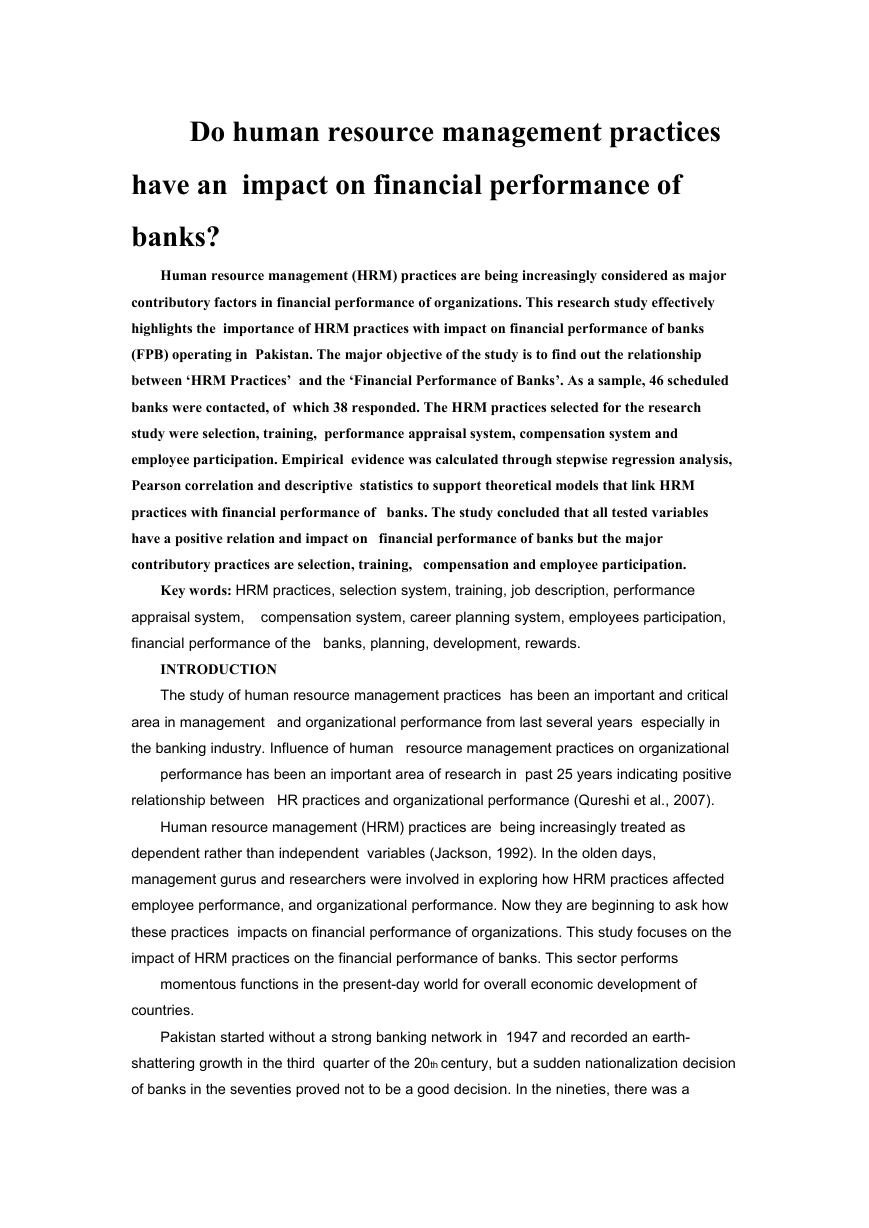
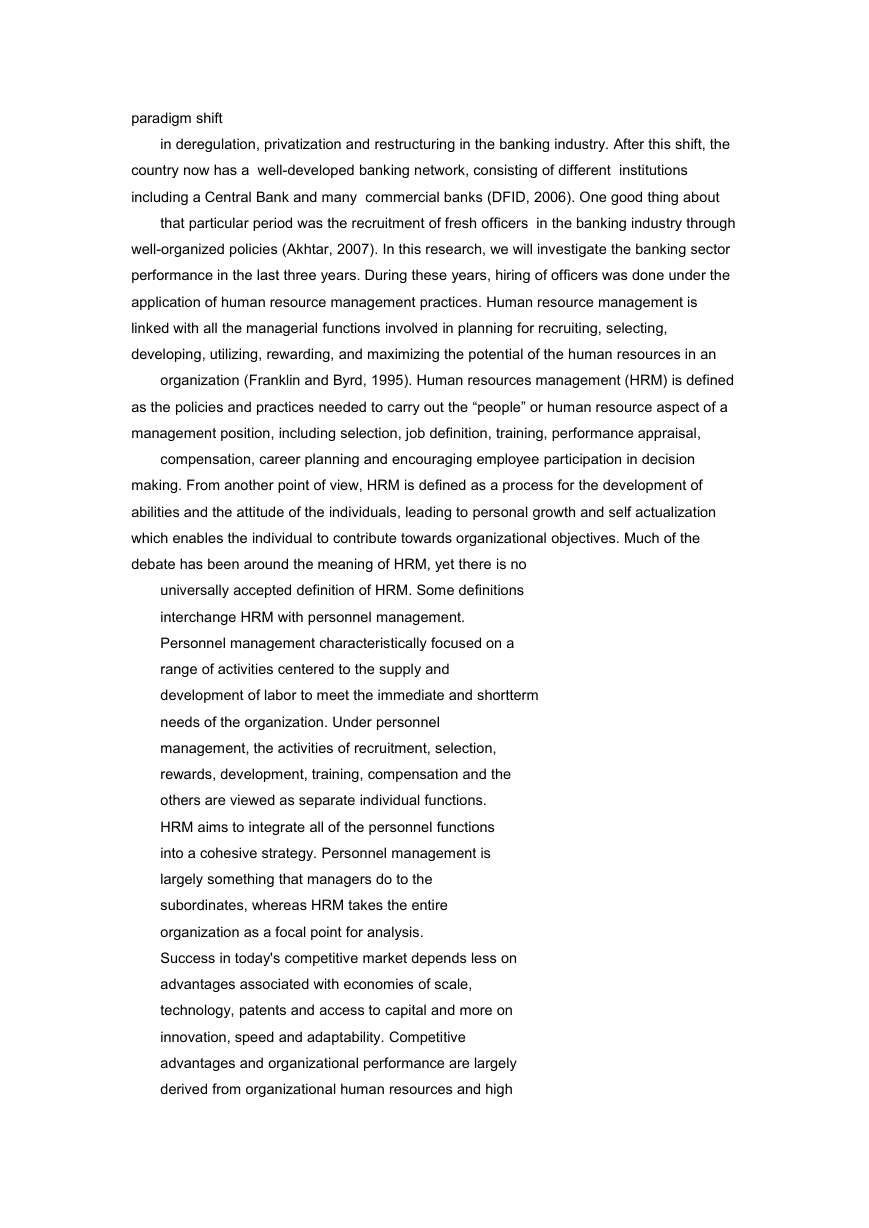
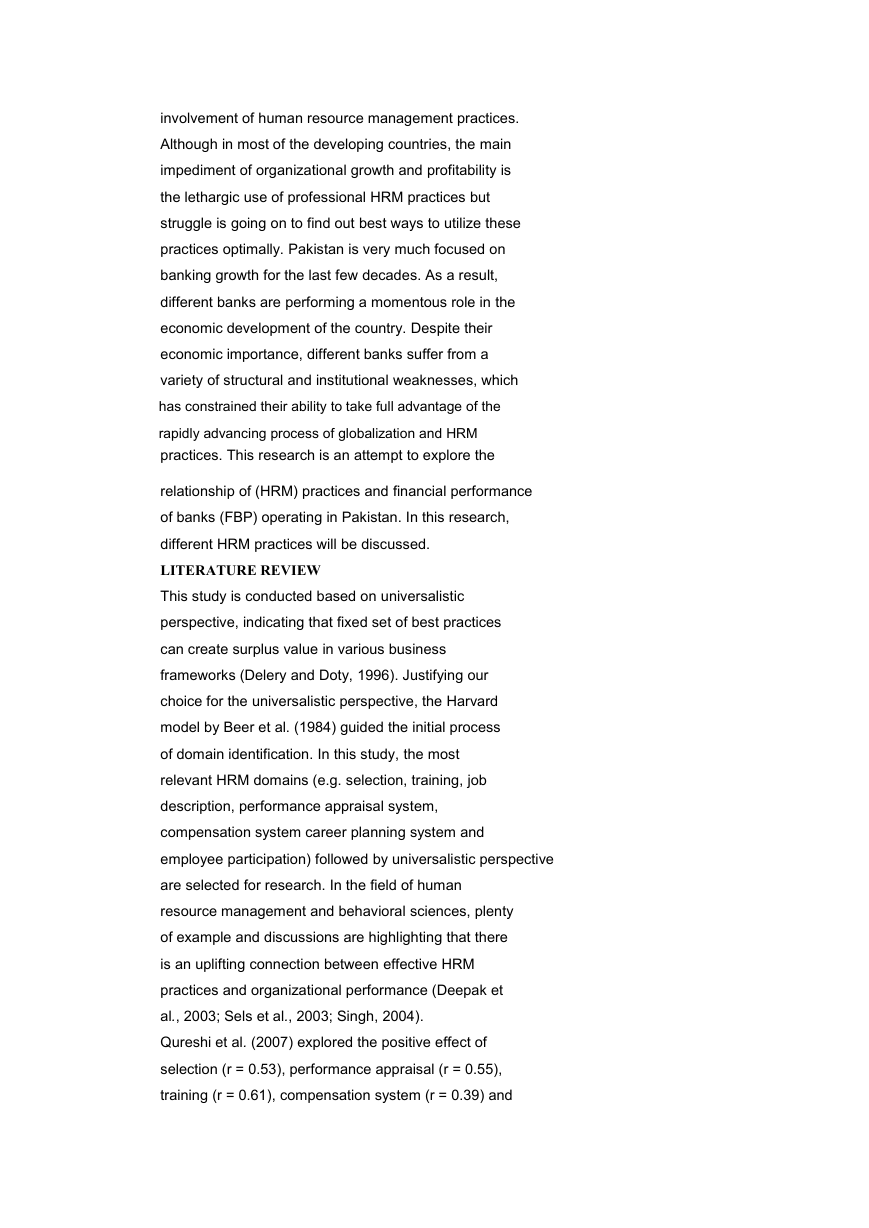

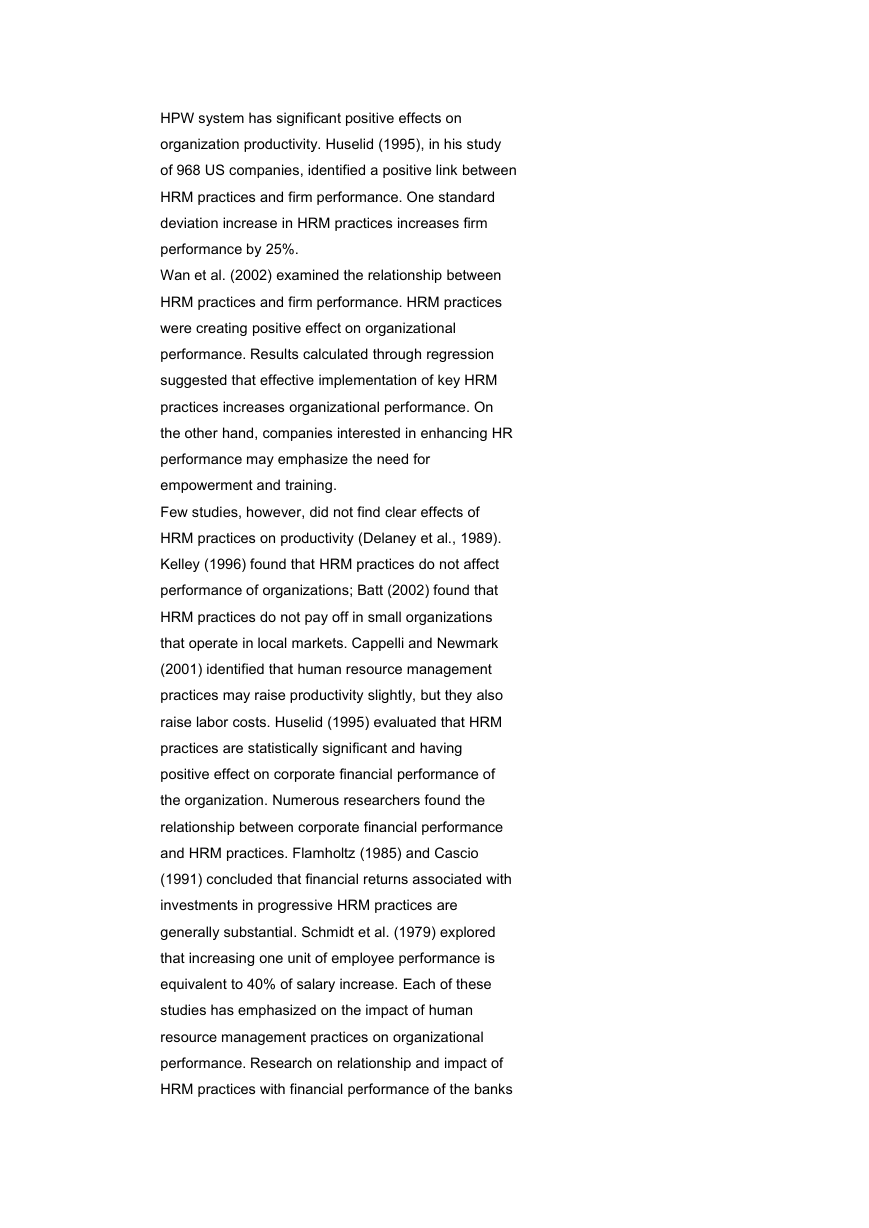
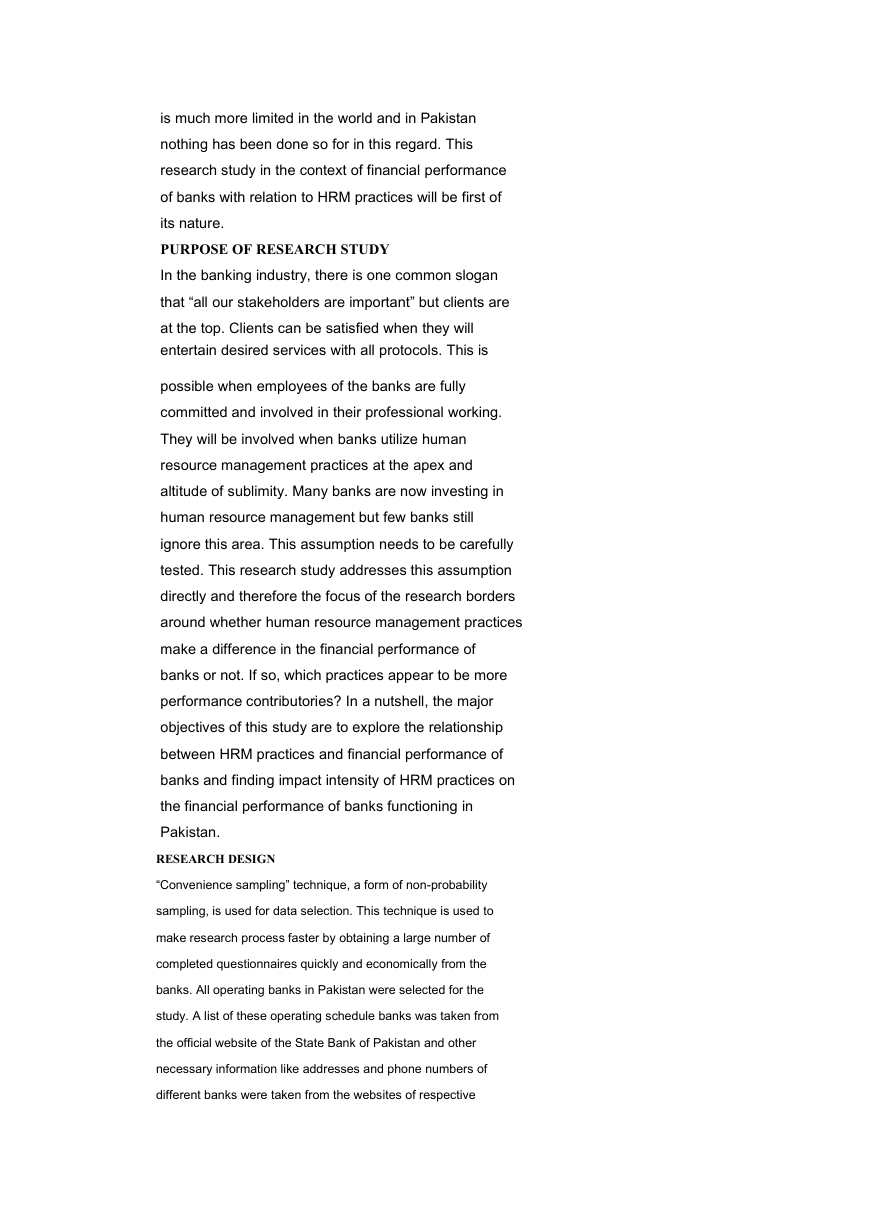
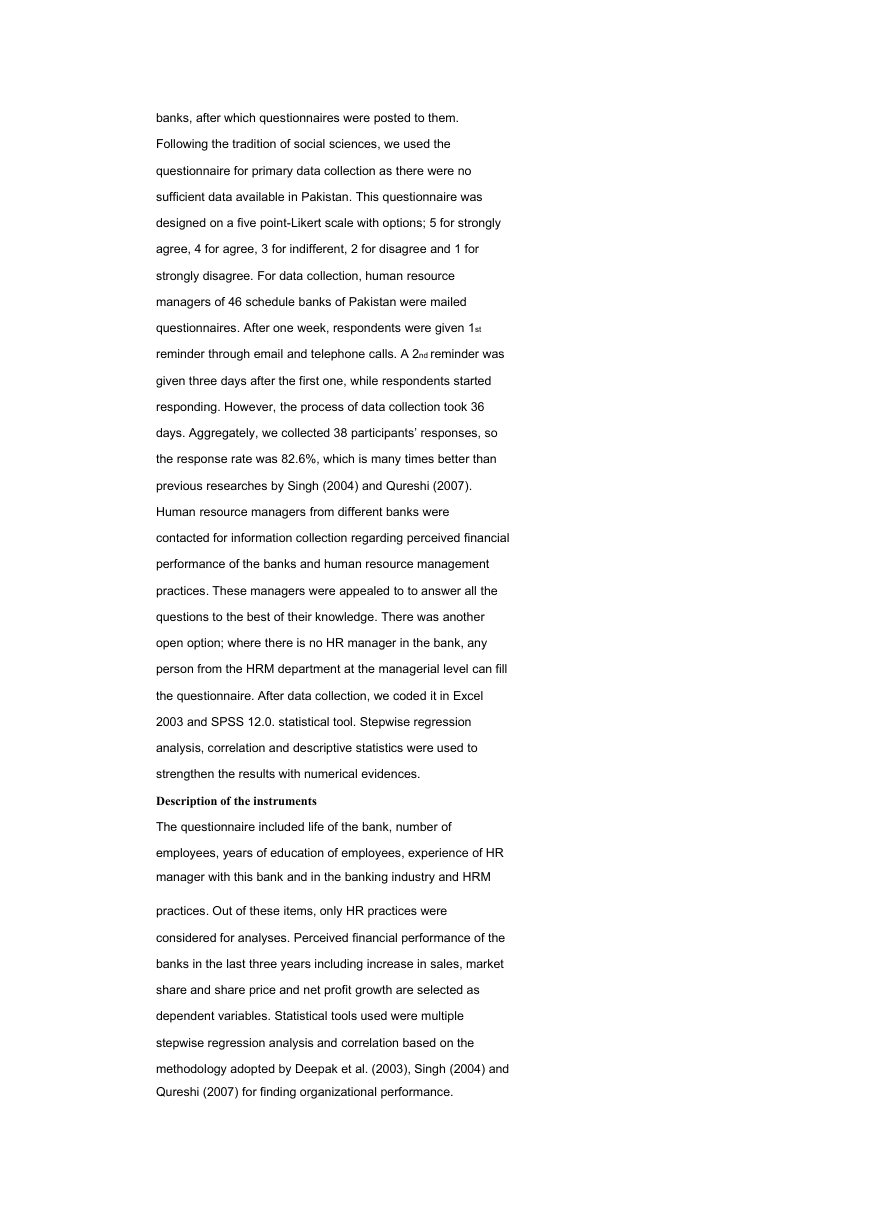
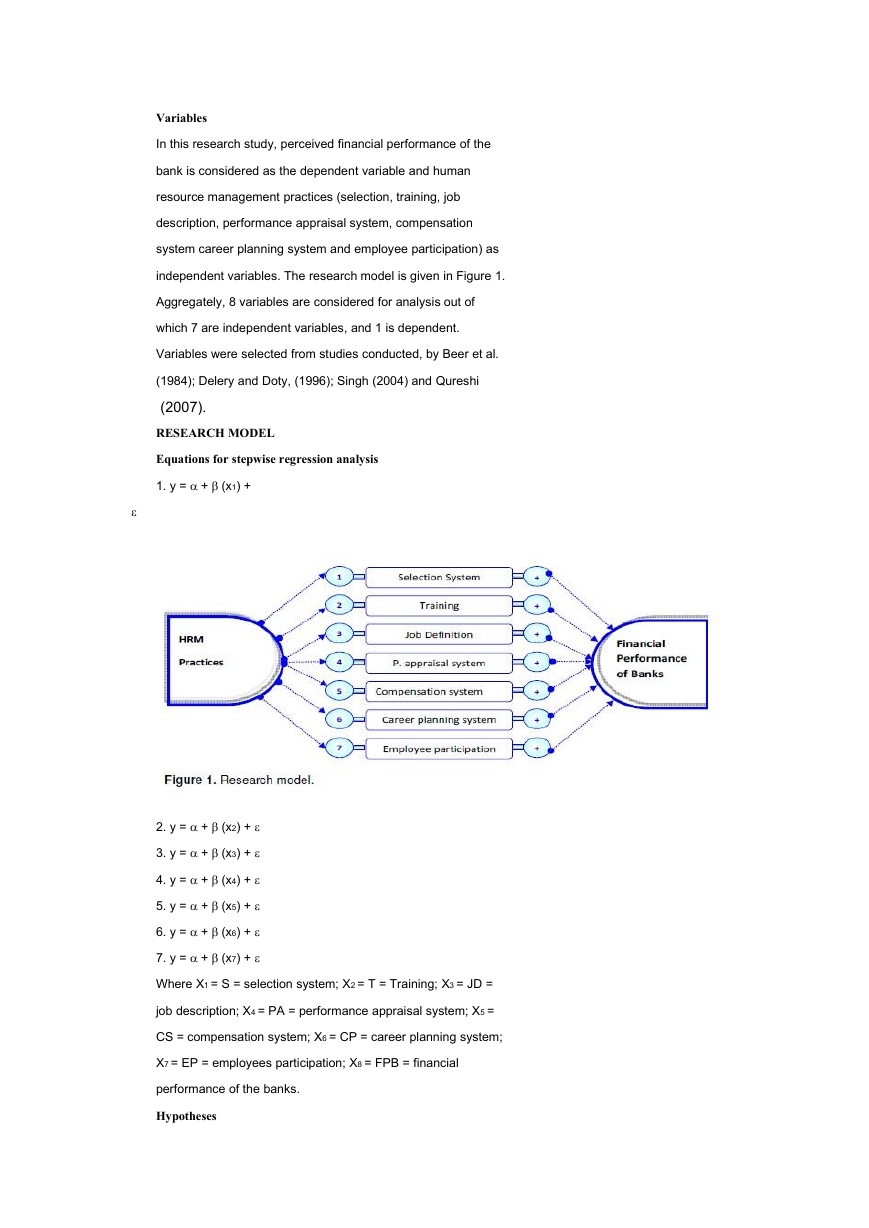








 2023年江西萍乡中考道德与法治真题及答案.doc
2023年江西萍乡中考道德与法治真题及答案.doc 2012年重庆南川中考生物真题及答案.doc
2012年重庆南川中考生物真题及答案.doc 2013年江西师范大学地理学综合及文艺理论基础考研真题.doc
2013年江西师范大学地理学综合及文艺理论基础考研真题.doc 2020年四川甘孜小升初语文真题及答案I卷.doc
2020年四川甘孜小升初语文真题及答案I卷.doc 2020年注册岩土工程师专业基础考试真题及答案.doc
2020年注册岩土工程师专业基础考试真题及答案.doc 2023-2024学年福建省厦门市九年级上学期数学月考试题及答案.doc
2023-2024学年福建省厦门市九年级上学期数学月考试题及答案.doc 2021-2022学年辽宁省沈阳市大东区九年级上学期语文期末试题及答案.doc
2021-2022学年辽宁省沈阳市大东区九年级上学期语文期末试题及答案.doc 2022-2023学年北京东城区初三第一学期物理期末试卷及答案.doc
2022-2023学年北京东城区初三第一学期物理期末试卷及答案.doc 2018上半年江西教师资格初中地理学科知识与教学能力真题及答案.doc
2018上半年江西教师资格初中地理学科知识与教学能力真题及答案.doc 2012年河北国家公务员申论考试真题及答案-省级.doc
2012年河北国家公务员申论考试真题及答案-省级.doc 2020-2021学年江苏省扬州市江都区邵樊片九年级上学期数学第一次质量检测试题及答案.doc
2020-2021学年江苏省扬州市江都区邵樊片九年级上学期数学第一次质量检测试题及答案.doc 2022下半年黑龙江教师资格证中学综合素质真题及答案.doc
2022下半年黑龙江教师资格证中学综合素质真题及答案.doc